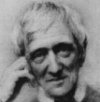
Did Jesus endorse slavery?This parable of Jesus was used as a proof that he did endorse slavery. For Jesus holds out the obedient slave as an example to us, it was said. Is this interpretation correct?
|
Interpreting Scripture Correctly
|
First ObservationParables and comparisons are like artistic representations in which we have to distinguish between the main assertion of the representation and artistic details. We can illustrate this observation best at the hand of an example. In John 20,11-18 we read:
Artists have depicted the scene in various forms.
|
||||||||||
The teaching scope of Jesus' parable of the humble slaveNow look at this video again (click on start arrow):
Teachers use images to present their message in an attractive form. But their scope is limited. They just want to teach the message. So we need to distinguish:
© John Wijngaards |
||||||||||
Credits
|
 |
 |
 |
 |
 |
|
|---|---|---|---|---|---|
| Facts |
 |
 |
 |
 |
|||